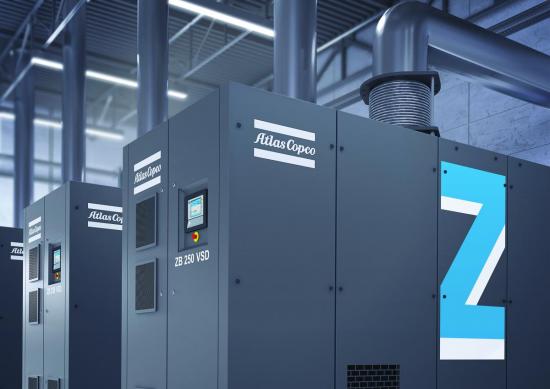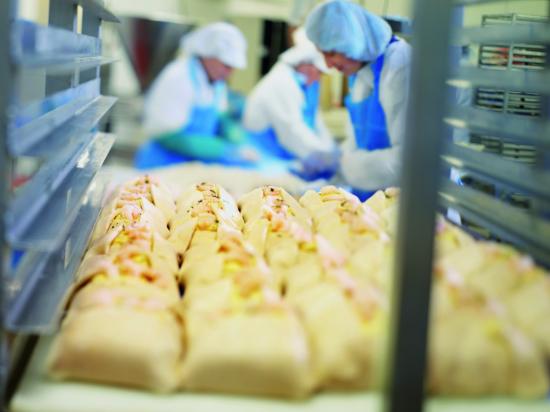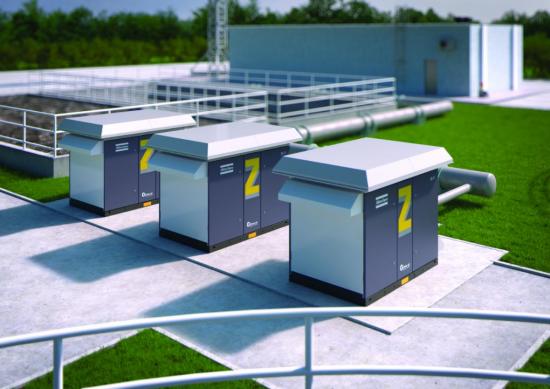Blower & Vacuum Best Practices interviewed Deepak Vetal, National Sales Manager, Blowers and Low-Pressure Compressors, Atlas Copco Compressors, LLC.
What low-pressure blower technologies does Atlas Copco offer for the food and industry?
We provide 100 percent oil-free blowers for working pressures up to 24 psig. Our product line consists of rotary screw blowers for pressures up to 22 psig, centrifugal blowers for pressures up to 20 psig, multistage centrifugal blowers up to 24 psig, lobe blowers for pressures up to 15 psig and we also offer low-pressure single stage screw compressor for pressures up to 60 psig typically for dense phase conveying and other applications which requires higher pressures.

An Atlas Copco ZB oil-free, direct drive centrifugal blower.
Please describe the food and beverage market and where these blowers are commonly used.
To put it in perspective, the food and beverage industry accounted for 12 percent of the U.S. gross domestic product in 2017. The main subsegments that use low-pressure air for numerous applications in this industry include meat processing, poultry, dairy product manufacturing, preserved fruits and vegetables, as well as brewing and beverage processes.
The primary use of low-pressure air in this market is pneumatic conveying in both vacuum and pressure. Many food manufacturers also operate wastewater treatment facilities independent from their municipalities to decontaminate process or sewage water and to treat organic waste.
There is growing demand in these areas for oil-free air and we see potential for growth for both blowers and vacuum.

Tell us about Atlas Copco’s commitment to oil-free technologies.
Atlas Copco has been a pioneer in the development of oil-free air technology for more than 60 years and it has resulted in a wide range oil-free air compressor and blower solutions for applications where users simply can’t make compromises when it comes to clean, 100 percent oil-free air.
Frankly, why add lubricant to the system in an application when it has to be taken out? Why not just reduce the risk of contamination up front and the severe consequences that can follow, whether its spoiled or unsafe products, legal issues that can damage a brand or any number of issues? Knowing the compressed air is 100 percent oil-free provides users with peace of mind. Oil-free blowers and air compressors also help users achieve energy efficiency and meet increasing government regulations. Oil-free air can also help reduce the need for service and parts.
We know ISO 22000 certification is important in food and beverage applications. Can you tell us about that?
ISO 22000 is a food safety management system that can be applied to any organization in the food chain. It addresses three primary safety hazards in food and beverage manufacturing, which are biological, chemical and physical.
A company must demonstrate its ability to control these food safety hazards according to the standard. To say we support the standard is an understatement. Our oil-free production facility in Antwerp, Belgium, is ISO 22000-certified. At that plant, we manufacture oil-free air compressors, blowers and air treatment products.
What’s involved in ISO 22000 Certification and what’s the advantage to earning it?
I’ll start with the benefits of the certification. It all goes back to consumers who continue to demand safe food, which will only increase with time. Food processors are looking to suppliers throughout the food chain to provide them with safe ingredients. Being ISO 22000-certified demonstrates that a company has a food safety management system in place that meets the established standard for safety and quality.
There’s a lot that goes into ISO 22000 since it incorporates proven Hazard Analysis and Critical Control Point (HACCP) principles and those of the Good Manufacturing Practice (GMP). Earning ISO 22000 Certification requires a documented food safety program to manage the processes throughout the facility. A company must also establish prerequisite programs to ensure a sanitary environment and institute an HACCP principal to identify, prevent and eliminates hazards.
Where does the ISO 8573-1 Class 0 standard come into play and how would you describe its importance in the food industry?
Anyone could say their blower or compressed air system delivers high quality air, but reality dictates that everyone involved knows what that means.
ISO 8573-1:2010 specifies and defines three primary contaminant types as prevalent in a compressed air system. These are solid particulates, water and oil, in both aerosol and vapor form. Each is categorized and assigned a quality class ranging from Class 0, which is the most stringent, to Class 5, which is the most relaxed. The end user-user is responsible for defining the air quality required for their particular application or process.
The standard is important for many reasons, one of which is the fact that it establishes a common language for discussing clean, dry air based on clear specifications. Equally important, it gives end users the ability to select the right compressed air system components for their operation because it allows them to effectively compare technical data from one manufacturer to another.
You identified a range of applications for blowers in this industry. Where is process air commonly used?
The main applications are fermentation, which is a process for controlling bacteria growth; aeration, which involves mixing and agitation in the production process; cooling and drying of the end product; and transporting of materials and the end product.
Walk us through a fermentation application that uses oil-free blowers.
Most fermentation processes share similarities in that a tank is filled with liquid and is then aerated to support the growth of bacteria during fermentation involved in producing food ingredients such as citric acid, wine, and yogurt. Aeration represents about 45 percent of the energy consumption of a typical fermentation plant.
And then you have aeration for wastewater treatment as you mentioned.
Wastewater is the one that most everyone is familiar with but there are other applications in the food industry, such as fish farming. Another example of aeration in combination with mixing is the process of foaming, which is when air is introduced into a product. Ice cream makers use this process to ensure the ice cream is easy to scoop. So those are just some examples, although most people don’t often think of fish and ice cream as products that have anything in common, that’s for sure.

An Atlas Copco ZS energy efficient oil-free screw blower system.
So fermentation and aeration are big ones. What about applications like cooling and drying and conveying?
Cooling and drying is a great example since the air often comes into direct contact with products like baked goods as part of the dehumidifying and drying process, which is crucial for eliminating moisture that can cause bacterial growth. Air supplied by low-pressure blowers is one of several options used to cost-effectively dry end products.
Food companies also use oil-free air to pneumatically convey food ingredients, such as powdered milk and cocoa powder, from incoming tank trucks into the silos for temporary storage. By using oil-free air they can avoid oil contaminant mixing with the powder and maintain its purity. This also prevents the potential for oil collecting on machines where equipment used in these areas, such as robotics arms.
How does the tank truck offloading process work with blowers?
Typically, the tanks on the trucks are pressurized with compressed air to convey the ingredients into the silo. Yet we’re seeing a growing number of companies using stationary blowers for this application instead of the trucks’ onboard air compressors.
Why would companies use stationary blowers for offloading ingredients?
There are multiple advantages to it, one of which is the ability to use a larger blower than you typically find on tank trucks, which speeds productivity.
Using onboard air compressors also requires trucks to run, which creates exhaust fumes and is very noisy. A stationary blower virtually eliminates those issues, which creates better working conditions and is more environmentally friendly.
And don’t forget product quality. A stationary blower system avoids sucking in the exhaust fumes reducing the product contamination.
There is clearly a wide range of applications, and they’re not always obvious.
That’s true. Food and beverage companies are finding many opportunities to address their goals, and many of them are critical.
Take fermentation for example. We worked with one of the United Kingdom’s largest yeast producer’s operation in Canada. The plant’s 22-hour fermentation process cycle, which has fluctuating pressure and flow requirements, relies on a continuous supply of oil-free low-pressure air to deliver oxygen to the stock yeast. Any disruptions were not acceptable since any interruption in airflow to a fermentation vessel results in failure of an entire batch.
Knowing this, the plant took proactive approach and explored using rotary screw blower to replace some conventional lob-type blowers since they experienced reliability issues with them. They eventually upgraded this system with rotary screw blowers, which addressed the reliability issue and saved them energy costs.
Calculating Aeration Flow and Pressure Requirements – Webinar RecordingDownload the slides and watch the recording of the FREE webinar to learn:
|
What actually happened at the yeast plant? How did they realize energy savings?
We did the project in phases given the critical nature of application. First, we installed an oil-free rotary screw blower as a supplementary unit to the conventional blowers to evaluate its reliability and the potential for energy efficiency.
After 12 months of excellent performance, the plant chose to install a complete blower installation comprised of three fix-speed rotary machines and three variable-speed blowers to supply air at pressures between 2.9 psig and 16.9 psig on three of its six fermentation units.
The new blowers not only cope with the fluctuations in process air demand but also operate from 100% capacity down to 25% capacity with very little change in the specific power requirement. Now, the yeast producer expects to reduce its energy cost by at least 25 percent.
What’s your advice for selecting blower technologies for food and beverage applications like these?
We always tell customers there is no single best technology. Choosing the best oil-free blower type begins with understanding the process and application. There are many factors to be considered, including capital cost, energy consumption, performance range, process requirements and maintenance.
The best advice is to work with a knowledgeable supplier to get a full understanding of the strengths of a given technology and deciding whether it’s the right blower for a specific process. Working with a supplier that has multiple blower types is also a good idea because there isn’t a bias toward one specific technology and allows ample opportunity to discuss all factors and questions that go into making the best choice.
Thank you for your insights.
For more information, please contact Deepak Vetal, National Sales Manager, Blowers and Low-Pressure Compressors, Atlas Copco, tel: 803 817-7248, email: deepak.vetal@us.atlascopco.com.
To read more Blower Technology articles, visit https://www.blowervacuumbestpractices.com/technology.



